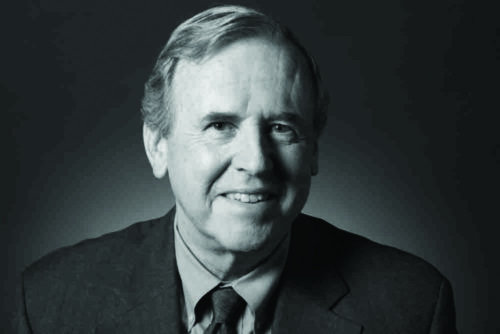We mourn a writer who shed a light on Irish monks who kept the fires of Christian learning alight during the Dark Ages, and in doing so, helped banish some of the stereotypes leveled at our race.
Best-selling author Thomas Cahill – who died on October 18 at the age of 82 – once described a bitter irony of history in this very magazine.
“Ireland had been a place of fabulous agricultural fertility,” the Bronx native and Fordham grad wrote in January 2000, five years after his book How the Irish Saved Civilization hit best-seller lists, going on to sell millions of copies and become a publishing franchise and phenomenon.
“The early Irish monks and nuns, who tried for a time to be as strict with themselves as the hermits of the Egyptian desert, found that it was just about impossible to starve properly in Ireland, because the country abounded in delicious food of all kinds – ‘leeks from the garden, poultry and game. Salmon and trout and bees,’” as one “salivating monastic poet of the seventh century” put it.
Of course, by the 1840s, things would change and change utterly in Ireland. For much of its past, however, Cahill wrote that “Irish hospitality and generosity were legendary,” and that “Irish monks opened their doors and their cupboards to England and all Europe, educating whoever came to them without charging for tuition, books, room, or board.” It was Cahill’s profound and original take on this concept – Ireland’s gift to the human race – that made him a literary star.
“To many … the title [How the Irish Save Civilization] sounded like a bunch of blarney – even in the early 1990s, many people still considered Ireland a conservative backwater and a cultural appendage to Britain,” Cahill’s New York Times obituary noted.
That all changed when the book came out in 1995. It was a sensation and became part of a broader mid-1990s Irish renaissance. Seamus Heaney also won the Nobel Prize in literature in 1995. Angela’s Ashes came out a year later, followed by a Hollywood movie based on Frank McCourt’s Pulitzer Prizewinning memoir. Meanwhile, Riverdance toured the U.S. to jam-packed houses. And in 1998, the Good Friday peace accords were signed, ultimately thrusting Ireland and its history, culture and artists onto front pages across the world – back when front pages were all that really mattered.
For Thomas Cahill, this seemed like an “overnight success” roughly two decades in the making.
He was born in 1940 to Margaret (Buckley) and Patrick Cahill, who worked in the insurance industry. Cahill attended Manhattan’s Regis High School before majoring in classical literature and philosophy at Fordham, on his way to becoming a Jesuit priest.
Instead, though, he enrolled at Columbia University during the turbulent late 1960s, studying literature and film, before embarking on what would become a lifelong, transAtlantic journey into Irish and world culture.
Cahill lived in Ireland in the early 1970s while researching and writing a book with his wife, Susan, called A Literary Guide to Ireland. He continued to write and work in publishing – specializing in religious books and authors – while planning a prospective seven-volume series on formative moments in Western civilization, which he did.
Following on the success of How the Irish Saved Civilization, he produced, The Gifts of the Jews; Desire of the Everlasting Hills; Sailing the Wine- Dark Sea: Why the Greeks Matter; Mysteries of the Middle Ages, and Heretics and Heroes, all well received. However, none caught the imagination or attracted the sales the way the first in his Hinges of History series did.
How the Irish Saved Civilization “argued that even though the Romans never conquered remote, rural Ireland, Christianity did – and that as the continent of Europe descended into darkness and anarchy … (Ireland’s) isolation became its advantage,” the Times obituary noted, adding: “Living in relative peace, Irish scholars transcribed countless pagan and Christian texts, maintained a semblance of literary culture and, perhaps most important, developed a lively, life-affirming Christianity that later seeded the revival of the Roman Catholic Church in Western Europe.”
True, some critics sensed “a touch of hyperbole,” in claiming “the Irish ‘singlehandedly refounded European civilization throughout the continent,’” as Richard Bernstein put it. But he added: “Cahill’s book is an entirely engaging, delectable voyage into the distant past, a small treasure.”
Millions of readers agreed. Cahill himself told Irish America magazine a few years ago: “My mother often quoted a saying of her own mother, an immigrant from Williamstown, Co. Galway: ‘When I had cash to treat the gang, this hand was never slow.’ It was actually a quotation from a late nineteenth century American barroom ballad, but my mother and her mother intended it as an encouragement to be generous whenever one could.”
Cahill added: “In recent years I noticed that an elderly neighbor, Shelly Wortzman, never passed a beggar without giving him a good-sized handout. So from my grandmother, whom I never met, the poetic advice of generosity to friends; from Shelly the silent example of generosity to strangers.”
Cahill spent decades describing all that the Irish had given to the human race.
Ultimately, that was his great gift to all of us.
In addition to his wife Susan, Cahill is survived by their daughter, Kristin Cahill-Iniguez; their son, Joseph; his sisters, Pat Holland, Mary Reitz and Annie Petralito; and four grandchildren. Cahill was working on the 7th book in his Hinges of History series when he passed away.


Is Susan Cahill or his family planning to complete the final book in the Hinges of History series?